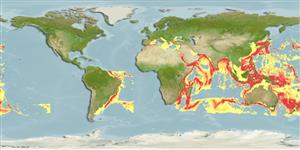Common names from other countries
Classification / Names / Names
Populärnamn | synonymer | Catalog of Fishes (gen., sp.) | ITIS | CoL | WoRMS
Environment: milieu / climate zone / depth range / distribution range
Ekologi
; brackvatten; djupintervall 0 - 4177 m (Ref. 107353). Tropical
Circumglobal.
Length at first maturity / Size / Vikt / Age
Maturity: Lm ? range ? - ? cm Max length : 3.0 cm WD hane/ej könsbestämd; (Ref. 7493)
Intertidal (Ref. 81522); Littoral to sublittoral fringe areas; known as a fouling species (Ref. 81749) - on piers, pontoons, and boat hulls (Ref. 102838). In sheltered (Ref. 125338) to exposed rocky shores. Can be found on the shells of predatory gastropods Reishia clavigera and Cellana toreuma (Ref. 127116). Part of both epibenthic and arboreal communities in mangrove areas (Ref. 128397). Sessile suspension feeder (Ref. 125928).
Life cycle and mating behavior
Könsmognad | Reproduktion | Lek | Ägg | Fecundity | Larver
Members of the superorder Thoracica are mostly hermaphroditic. Broadcast spawners, fertilization occurs in the mantle cavity. Life cycle: Eggs hatch into planktonic nauplii and leave the mantle cavity. Afterwards, they undergo six naupliar instars succeded by nonfeeding cypris larva (settling stage) which later metamorphose into adults.
Paulay, G. and A. Ross. 2003. (Ref. 7493)
IUCN Red List Status (Ref. 130435)
CITES status (Ref. 108899)
Not Evaluated
Not Evaluated
Human uses
| FishSource |
Verktyg
Internet-källor
Estimates based on models
Preferred temperature
(Ref.
115969): 2.8 - 13.7, mean 4.5 (based on 1972 cells).
Resiliens
Hög, lägsta populationsfördubblingstid mindre än 15 månader (K=0.44-0.47).
Vulnerability
Low vulnerability (10 of 100).
Price category
Unknown.
